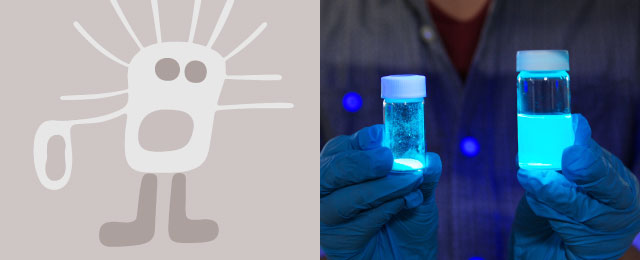







Home > Research > Research Highlights > Agricultural sciences > URAKAWA Shuji - Aiming for a cyclical-type area model that is food self-sufficient through regional unity and agriculture-industry cooperation.
date: 2020.02.25
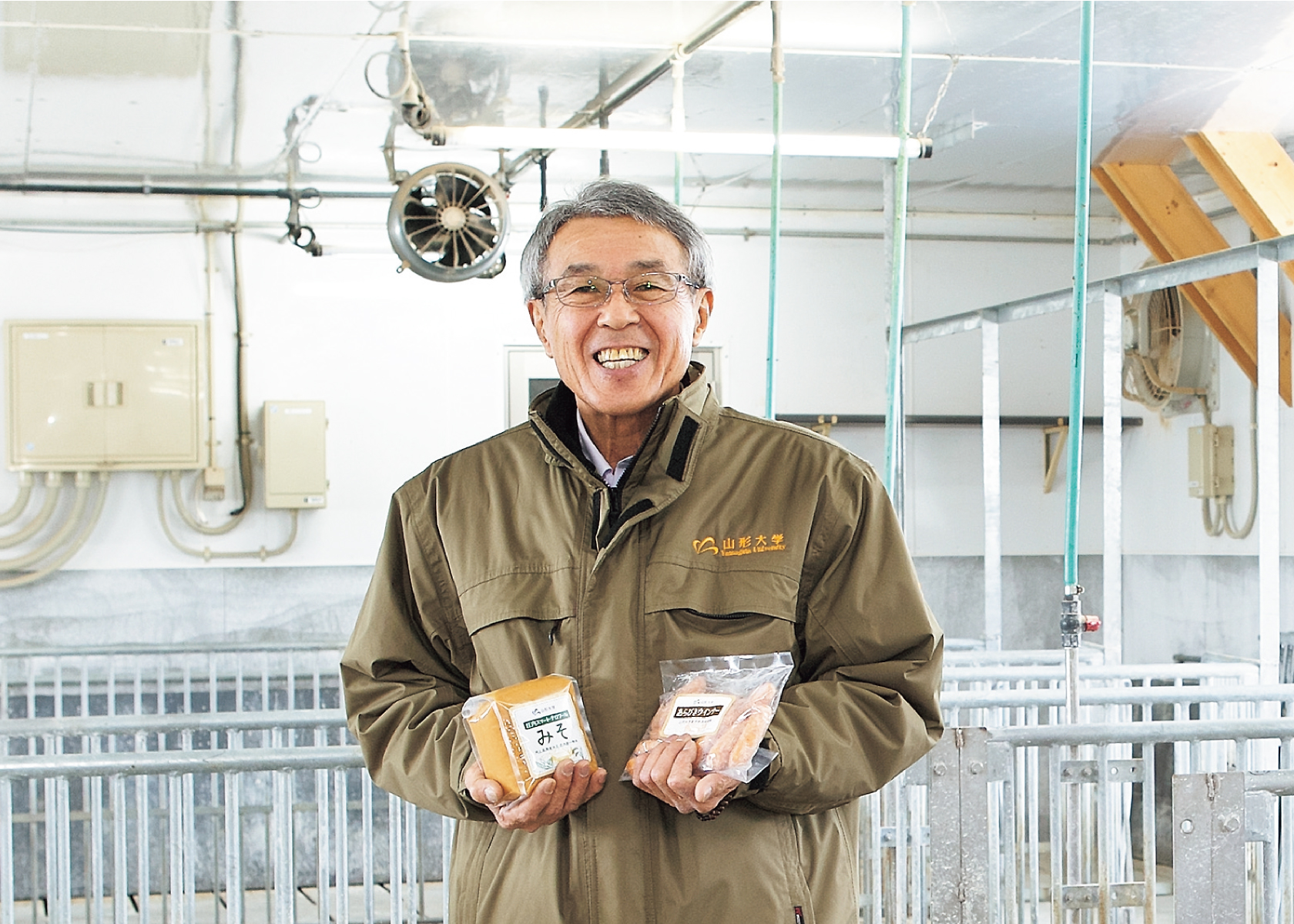
Since April 2016, the Faculty of Agriculture has established the endowed course “Seminar for Building a Food Self-Sufficient Area (Smart Terroir)," and is conducting verification research for the purpose of building a food self-sufficient area within the Shonai region. This course is a five-year project that aims to build a cyclical economic area which can accomplish everything it needs to be self-sufficient through farming cooperation, agricultural and industrial cooperation, and local consumption. Now, with the third year of the project completed, we visited the Yamagata Field Science Center in the Faculty of Agriculture at Yamagata University to learn about the program's challenges and its outlook for the future.
Mr. Masahiko Matsuo, former chairman and CEO of Calbee, Inc., wanted to verify his theories about food self-sufficient areas (“smart terroirs”), which he proposed in his self-authored book “Smart Terroir: A Major Reversal from the Theory of Rural Extinction,” and sought a place to conduct research. From Mr. Matsuo’s friendship with Yamagata University President Koyama, it was decided that the research would unfold at the Yamagata Field Science Center in the Faculty of Agriculture at Yamagata University, and the five-year project began as an endowed course, “Seminar for Building a Food Self-Sufficient Area (Smart Terroir)." The central figure managing the project is Professor Shuji Urakawa, head of the Section of Ecological Farming at said Center and a specialist in animal husbandry and feed science.
The central axis of a smart terroir has three components: “farming cooperation,” which aims to link farming and livestock breeding to produce agricultural and livestock products; “agricultural and industrial cooperation,” which joins them together with processing companies to create processed foods using carefully selected materials; and “local consumption,” which is selling and consuming those products within the area. A smart terroir aims to build a cyclical economic area where all of these components can be completed locally. In farming cooperation, the imperfect or surplus agricultural products of farmers who grow agricultural products to be processed are supplied to livestock breeders as animal feed, and livestock breeders provide agricultural product growers with high-quality manure. In agricultural and industrial cooperation, processing companies produce miso, soy sauce, tofu, bread and other products using carefully selected materials from agricultural products grown by farmers, and meat processing companies produce ham, sausage and other products using fattened livestock raised by livestock breeders. Local consumption refers to the provision of delicious processed foods, made using carefully selected local ingredients, to area residents via retail stores, restaurants, hospitals, schools and shops. The formation of a cyclical economic area where all of these aspects can be completed locally is called a “smart terroir.”
The first thing this project did to construct a system for farming cooperation was to raise pigs. The Shonai area, where the Faculty of Agriculture is located, has thriving pig farms. Pigs, which will eat anything, are good for a feed diet of imperfect and surplus produce, and from the viewpoint of agricultural and industrial cooperation, they are also suitable for meat processing, and so they became the optimal choice. However, there was no pigsty at the Yamagata Field Science Center to conduct fattening experiments, so the project became a large-scale endowed course that also included the construction of a pigsty. Furthermore, as something that would contribute to research and education at the university, the project received a magnificent pigsty donation with more robust equipment than a regular pigsty.
The project operates a cycle of procuring piglets up to 30kg in weight from local livestock breeders, fattening them up to roughly 110 kg in about three to four months, then shipping them to meat processing companies. On the basis of the scale of the pigsty, it would be possible to raise more pigs, but in order to secure a reasonable amount of space for them to exercise, and raise them in a stress-free environment, the project fattens up roughly 20-25 pigs at a time. The feed given to the pigs at the pigsty is prepared from imperfect and surplus produce - potatoes, soybeans, and wheat - grown by university-affiliated farms and cooperating farmers' test sites in Gassan, as well as feed corn. It is a simple process to prepare the soybeans, wheat, and feed corn; they are dried, ground and stored. On the other hand, because potatoes are washed, ground, mixed, sealed and stored to make silage, they require a great deal of time and effort. At the small-scale experimental stage, the students are rendering their assistance, but it is thought there will be a future need to establish easy preparation techniques in the event that the project expands in scale.
One of the things to pay attention to here is that the "farms" in farming cooperation, an important piece of the smart terroir, are not rice paddies, but fields. That is because the amount of rice consumption has steadily declined. Since around 1960, when annual rice consumption was two bags per person, the amount of consumption has decreased by half in about 60 years, and Mr. Matsuo thought that it was not possible to foresee a future increase in consumption. Conversely, consumption of foods like bread, noodles and tofu has increased, and he took notice of the fact that wheat and soybeans, which are the raw ingredients for those foods, have very low rates of self-sufficiency. The project is aiming to create a structure that will convert excess rice paddies into fields and increase these fields' production of agricultural products for processing, and then pass on the imperfect and surplus produce to livestock breeders for use as feed.
Shonai is rice country, and Prof. Urakawa was initially unsure about whether or not this project to repurpose rice paddies into farmland would be accepted. On the other hand, there has been an increase in abandoned rice paddies in the Shonai area, primarily in the central mountainous region where the conditions are poor and growing rice is inefficient, and it is said that there are roughly 1,400 ha of excess paddy fields. That was why Prof. Urakawa emphasized farmland zoning. While leaving the rich rice paddies in the Shonai plains as they were, the slopes of small plot rice paddies in the unfavorable areas of the central mountainous region were eliminated and consolidated, making use of the gentle slopes to create well-drained fields. In 2018, the project aimed to produce high-yield, high-quality agricultural products for processing through a rotation of potatoes, soybeans, wheat and feed corn, and at the Gassan test site, it produced agricultural products for processing and feed corn, in addition to conducting various tests and surveys. These tests and surveys included selecting the best kind of soybean for a mountainous region, examining the optimal time to harvest fully ripe soybeans, considering labor-saving techniques through dense planting, considering the cultivation of Akimaki wheat in the central mountainous region, and selecting the optimal variety of feed corn for the Shonai region. The project is also cultivating two potato varieties in scattered farm fields.
Naturally, other than feed corn, the main shipments are agricultural products to be made into processed foods, and the livestock breeder side accepts that there will be a gap between supply and demand according to whether the crops have a good or poor harvest. For example, when there is an abundant potato harvest, the livestock breeders receive the surplus produce and fatten their livestock with mixed feed containing an increased amount of potato, with the aim of stabilizing crop prices. Conversely, when there is a bad harvest, they reduce the amount of potato in the feed and fatten their livestock with mixed feed containing increased amounts of wheat, soybeans and corn. At present, the self-sufficiency rate in Japan for pork is around 50%, but Japan relies on around 80% imports when it comes to processed pork products. Furthermore, livestock breeders depend almost entirely on imported feed for fattening their livestock, even for domestically raised pigs, which is said to be putting livestock breeding businesses under pressure. If it were possible to provide imperfect produce such as potatoes, soybeans and wheat for free through farming cooperation, that problem would be eliminated. Meanwhile, through the provision of free high-quality compost from pig manure to crop farmers from livestock breeders, it would be possible to expect yield increases due to soil improvement.
One of the smart terroir’s early achievements was the production of “all Shonai” ham, sausages and bacon, where Shonai meat processing companies make pork products from pigs that were raised on a diet of Shonai agricultural products, which are then delivered to Shonai consumers. Through the cooperation of local meat processing companies that have agreed to cooperate with smart terroir agricultural and industrial cooperation, products are being made from pork from pigs that were raised in the university pigsty as the raw ingredients, with as few preservatives as possible. Yamagata University-branded ham, sausages and bacon, which took two years to complete, have been regularly sold in two Tsuruoka City and Sakata City supermarkets since July 2018. Once a month, students in matching happi coats stand at the storefront, conduct taste tests and sales, and make appeals about the university-branded products being safe and delicious. Helped by local residents’ desire to support the students, the products have become popular, and almost all their stock sells out every time. In particular, the wiener sausages have received glowing reviews, with comments such as “They’re crisp and firm, but easy to chew and swallow,” and “They’re light but they’re delicious and have a depth of flavor!” and there are many repeat customers.
Furthermore, as the second stage of agricultural and industrial cooperation following the processed meat products, “Shonai Smart Terroir Miso,” produced by Yamagata University, was completed and went on sale at the end of last year. The miso, a product created through the cooperation of local processing companies and made using high-quality soybeans grown by cooperating farmers at the Gassan test site in the Haguro area of Tsuruoka City, has also earned popularity. “The reason we were able to start the project and develop and sell both processed meat products and processed soybean products in just three years is because we can also have producers and retailers involved in product development, directly reflect the needs of consumers in the products, and flexibly make shipments,” Prof. Urakawa says. Producers, processing companies, and retailers were able to come together and work on product development as a team due in large part to the cooperation of local farmers and businesses. To express gratitude to those local people and related parties, every year in November, Yamagata University hosts a “Great Harvest Festival.” After a presentation of the year’s initiatives in a symposium format, there are taste tests of the processed meat products and soybean products that are the end result, among other events.
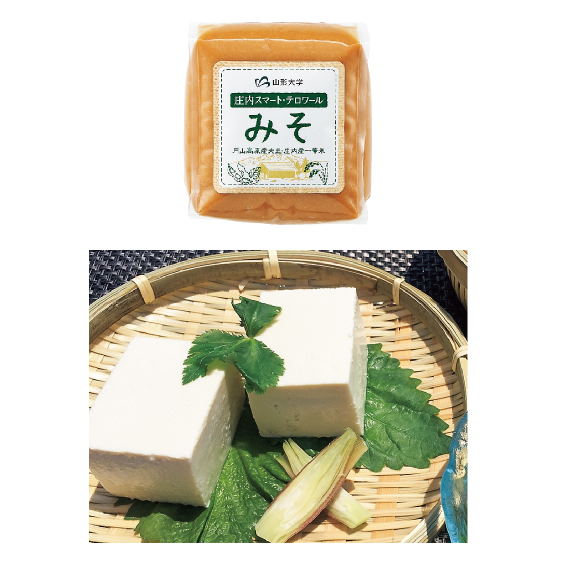
▲Shonai Smart Terroir-branded products, produced by Yamagata University
Shonai Smart Terroir Miso, made by local processing companies using high-quality soybeans grown by cooperating farmers, is available at local supermarkets. Tofu and soy sauce are undergoing trial production.
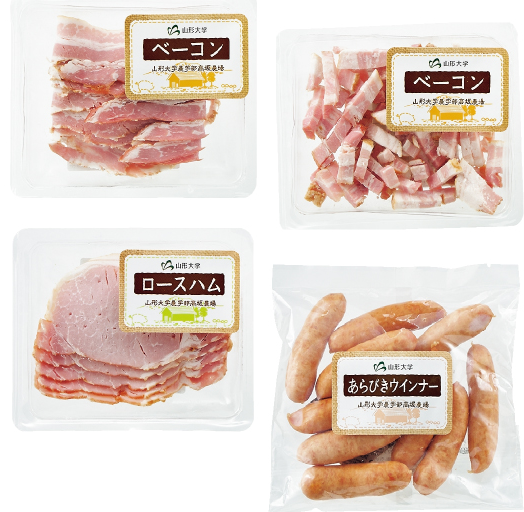
▲Yamagata University-branded processed meat products
Through the cooperation of local processing companies, pork from pigs fattened at the university is processed and made into ham, sausage and bacon products. They are sold at local supermarkets, and have become popular products.
As for the plan for AY2019, the project's fourth year, the first thing to do in order to expand farming cooperation will be to obtain cooperation from pig farmers, boost the number of fattened pigs raised on smart terroir-designated mixed feed, and increase production of processed meat products. Here, the issue is that even though the raw ingredients for the feed—imperfect and surplus produce—are free, processing them costs money. At the verification research level, students are being valuable assets and preparing the feed, but when the project actually proposes this system to pig farmers, it will be necessary to make the proposal along with labor saving and reduced costs. There are actually students working on this as a research topic. In addition, when converting swine manure into compost, if the operation becomes larger in scale, it will become necessary to consider a farming cooperation system through compost centers. Tsuruoka City has shown understanding toward this project, which has been able to receive various kinds of cooperation and assistance.
To implement the project locally in the future, it will also be necessary to conduct verification tests on the business side of things, so that farmers and businesses who support the smart terroir can participate with peace of mind. Together with that, the project will also continue to work as a team to develop new products using carefully selected potato, soybean and wheat products as raw material. Test production of soybean products—tofu and soy sauce—has already begun, and with regard to potatoes and wheat, selection of the items to be processed is underway.
There are two years to go for the project, but Mr. Matsuo himself had perceived a grand idea of a 30-year vision. The university has been tackling the project through a policy of steadily expanding its scope and establishing its roots over a further five or ten years, while verifying project results every five years.
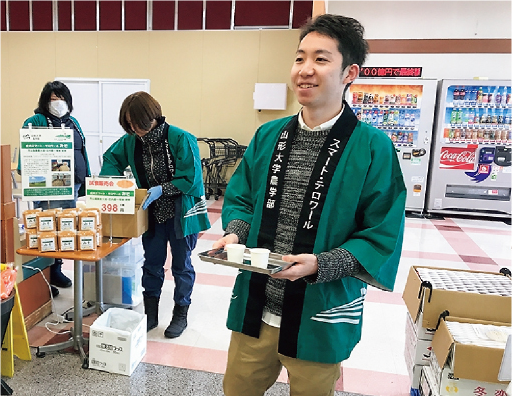
▲Miso taste tests and sales
Students from the Faculty of Agriculture doing PR for Shonai Smart Terroir Miso by conducting taste tests and sales at local supermarkets
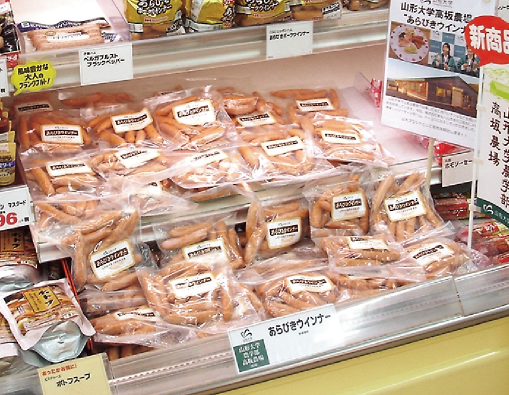
▲Sales at local supermarkets within Tsuruoka City
A sales counter for Yamagata University-branded ham, bacon and sausage. There is a growing number of repeat customers, who say that the products are delicious.
PROFILE
Specializes in crop production science, animal husbandry, and feed science. Graduate of Azabu University. Holds a Ph.D. in Agriculture (Kyoto University). After working for Mie Prefecture and the National Agriculture and Food Research Organization’s Institute of Livestock and Grassland Science, took up his post at Yamagata University. Head of the Section of Ecological Farming at the Yamagata Field Science Center in the Faculty of Agriculture.
※Article, affiliations, etc. are from March 2019.
Related Links